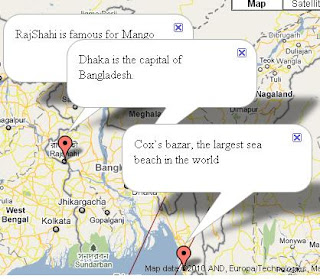Today, I will discuss about InfoWindow of the Google MAP API V3. At first I will show how to attach InfoWindow with each marker. As a result, when you will click a marker figure 1 an InfoWindow will be displayed. Then click another marker a new InfoWindow will be displayed without closing the previous InfoWindow, see figure 1. It is a default behavior of the Google Map API V3. To do this, follow the following steps: Step 1 : Create Google MAP API V3 map object: var latlng = new google.maps.LatLng(23.922499,91.164062); var myOptions = { zoom:6, center: latlng, mapTypeId: google.maps.MapTypeId.ROADMAP, }; gmap = new google.maps.Map(document.getElementById("map"), myOptions); Step 2: Create three objects. Each object contains three attributes, lat as latitude, lan as longitude, and txt as content of the InfoWindow. Create an array and insert three objects into the array. U
